Sediment Microbial Diversity in Urban Piedmont North Carolina Watersheds Receiving Wastewater Input
Abstract
1. Introduction
2. Materials and Methods
2.1. Sample Collection
2.2. DNA Extraction
2.3. 16S rRNA Library Preparation and Illumina Sequencing
2.4. Sequence Trimming and Quality Filtering
2.5. 16S Sequencing Analysis
2.6. Statistical Methods for Microbial Community Structure
3. Results
3.1. Phylum and Family Level Community Composition 16S Analysis Reveals Strong Microbial Differences Across the Watershed
3.2. Taxa with <97% Identity to the SILVA Database Indicate Biological Novelty in Our Samples That Are Distributed Differently at Upstream and Downstream Sites
3.3. ASV Analysis Reveals Exclusion of Distinct Taxa in Different Habitats
4. Discussion
4.1. Is Urbanization Homogenizing Aquatic Microbes?
4.2. Is There Potential for Novel Biodiversity in Urban Stream Environments?
4.3. Are Upstream and Downstream Communities Diverging over Time?
4.4. Are There Indicator Taxa for Downstream Sediment Impact by WWTP Exposure?
5. Conclusions
Supplementary Materials
Author Contributions
Funding
Acknowledgments
Conflicts of Interest
References
- Fisher, M.M.; Triplett, E.W. Automated Approach for Ribosomal Intergenic Spacer Analysis of Microbial Diversity and Its Application to Freshwater Bacterial Communities. Appl. Environ. Microbiol. 1999, 65, 4630–4636. [Google Scholar] [CrossRef] [PubMed]
- Zeglin, L.H. Stream microbial diversity in response to environmental changes: Review and synthesis of existing research. Front. Microbiol. 2015, 6, 454. [Google Scholar] [CrossRef] [PubMed]
- Zhang, J.; Yang, Y.; Zhao, L.; Li, Y.; Xie, S.; Liu, Y. Distribution of sediment bacterial and archaeal communities in plateau freshwater lakes. Appl. Microbiol. Biotechnol. 2015, 99, 3291–3302. [Google Scholar] [CrossRef] [PubMed]
- Hosen, J.D.; Febria, C.M.; Crump, B.C.; Palmer, M.A. Watershed Urbanization Linked to Differences in Stream Bacterial Community Composition. Front. Microbiol. 2017, 8, 1452. [Google Scholar] [CrossRef]
- Simonin, M.; Voss, K.A.; Hassett, B.A.; Rocca, J.D.; Wang, S.-Y.; Bier, R.L.; Violin, C.R.; Wright, J.P.; Bernhardt, E.S. In search of microbial indicator taxa: Shifts in stream bacterial communities along an urbanization gradient. Environ. Microbiol. 2019, 21, 3653–3668. [Google Scholar] [CrossRef]
- Jezbera, J.; Jezberová, J.; Kasalický, V.; Šimek, K.; Hahn, M.W. Patterns of Limnohabitans Microdiversity across a Large Set of Freshwater Habitats as Revealed by Reverse Line Blot Hybridization. PLoS ONE 2013, 8, e58527. [Google Scholar] [CrossRef]
- Newton, R.J.; Jones, S.E.; Eiler, A.; McMahon, K.D.; Bertilsson, S. A guide to the natural history of freshwater lake bacteria. Microbiol. Mol. Biol. Rev. 2011, 75, 14–49. [Google Scholar] [CrossRef]
- Newton, R.J.; McLellan, S.L.; Dila, D.K.; Vineis, J.H.; Morrison, H.G.; Eren, A.M.; Sogin, M.L. Sewage Reflects the Microbiomes of Human Populations. mBio 2015, 6, e02574-14. [Google Scholar] [CrossRef]
- Staley, C.; Gould, T.J.; Wang, P.; Phillips, J.; Cotner, J.B.; Sadowsky, M.J. Core functional traits of bacterial communities in the Upper Mississippi River show limited variation in response to land cover. Front. Microbiol. 2014, 5, 414. [Google Scholar] [CrossRef]
- Cuffney, T.F.; Kashuba, R.; Qian, S.S.; Alameddine, I.; Cha, Y.K.; Lee, B.; Coles, J.F.; McMahon, G. Multilevel regression models describing regional patterns of invertebrate and algal responses to urbanization across the USA. J. N. Am. Benthol. Soc. 2011, 30, 23. [Google Scholar] [CrossRef]
- Newton, R.J.; McLellan, S.L. A unique assemblage of cosmopolitan freshwater bacteria and higher community diversity differentiate an urbanized estuary from oligotrophic Lake Michigan. Front. Microbiol. 2015, 6, 1028. [Google Scholar] [CrossRef]
- Brown, L.R.; Cuffney, T.F.; Coles, J.F.; Fitzpatrick, F.; McMahon, G.; Steuer, J.; Bell, A.H.; May, J.T. Urban streams across the USA: Lessons learned from studies in 9 metropolitan areas. J. N. Am. Benthol. Soc. 2009, 28, 1051–1069. [Google Scholar] [CrossRef]
- Vandewalle, J.L.; Goetz, G.W.; Huse, S.M.; Morrison, H.G.; Sogin, M.L.; Hoffmann, R.G.; Yan, K.; McLellan, S.L. Acinetobacter, Aeromonas and Trichococcus populations dominate the microbial community within urban sewer infrastructure. Environ. Microbiol. 2012, 14, 2538–2552. [Google Scholar] [CrossRef] [PubMed]
- Drury, B.; Rosi-Marshall, E.; Kelly, J.J. Wastewater treatment effluent reduces the abundance and diversity of benthic bacterial communities in urban and suburban rivers. Appl. Environ. Microbiol. 2013, 79, 1897–1905. [Google Scholar] [CrossRef]
- Chu, B.T.T.; Petrovich, M.L.; Chaudhary, A.; Wright, D.; Murphy, B.; Wells, G.; Poretsky, R. Metagenomics Reveals the Impact of Wastewater Treatment Plants on the Dispersal of Microorganisms and Genes in Aquatic Sediments. Appl. Environ. Microbiol. 2018, 84, e02168-17. [Google Scholar] [CrossRef] [PubMed]
- Drury, B.; Scott, J.; Rosi-Marshall, E.J.; Kelly, J.J. Triclosan exposure increases triclosan resistance and influences taxonomic composition of benthic bacterial communities. Environ. Sci. Technol. 2013, 47, 8923–8930. [Google Scholar] [CrossRef]
- Rocca, J.D.; Simonin, M.; Blaszczak, J.R.; Ernakovich, J.G.; Gibbons, S.M.; Midani, F.S.; Washburne, A.D. The Microbiome Stress Project: Toward a Global Meta-Analysis of Environmental Stressors and Their Effects on Microbial Communities. Front. Microbiol. 2018, 9, 3272. [Google Scholar] [CrossRef]
- Lambirth, K.; Tsilimigras, M.; Lulla, A.; Johnson, J.; Al-Shaer, A.; Wynblatt, O.; Sypolt, S.; Brouwer, C.; Clinton, S.; Keen, O.; et al. Microbial Community Composition and Antibiotic Resistance Genes within a North Carolina Urban Water System. Water 2018, 10, 1539. [Google Scholar] [CrossRef]
- Rosi, E.J.; Bechtold, H.A.; Snow, D.; Rojas, M.; Reisinger, A.J.; Kelly, J.J. Urban stream microbial communities show resistance to pharmaceutical exposure. Ecosphere 2018, 9, e02041. [Google Scholar] [CrossRef]
- Caucci, S.; Karkman, A.; Cacace, D.; Rybicki, M.; Timpel, P.; Voolaid, V.; Gurke, R.; Virta, M.; Berendonk, T.U. Seasonality of antibiotic prescriptions for outpatients and resistance genes in sewers and wastewater treatment plant outflow. FEMS Microbiol. Ecol. 2016, 92, fiw060. [Google Scholar] [CrossRef]
- Rodriguez-Mozaz, S.; Chamorro, S.; Marti, E.; Huerta, B.; Gros, M.; Sànchez-Melsió, A.; Borrego, C.M.; Barceló, D.; Balcázar, J.L. Occurrence of antibiotics and antibiotic resistance genes in hospital and urban wastewaters and their impact on the receiving river. Water Res. 2015, 69, 234–242. [Google Scholar] [CrossRef] [PubMed]
- Baral, D.; Dvorak, B.I.; Admiraal, D.; Jia, S.; Zhang, C.; Li, X. Tracking the Sources of Antibiotic Resistance Genes in an Urban Stream during Wet Weather using Shotgun Metagenomic Analyses. Environ. Sci. Technol. 2018, 52, 9033–9044. [Google Scholar] [CrossRef] [PubMed]
- Bolger, A.M.; Lohse, M.; Usadel, B. Trimmomatic: A flexible trimmer for Illumina sequence data. Bioinformatics 2014, 30, 2114–2120. [Google Scholar] [CrossRef] [PubMed]
- Zhang, J.; Kobert, K.; Flouri, T.; Stamatakis, A. PEAR: A fast and accurate Illumina Paired-End reAd mergeR. Bioinformatics 2014, 30, 614–620. [Google Scholar] [CrossRef] [PubMed]
- FASTX-Toolkit. Available online: http://hannonlab.cshl.edu/fastx_toolkit/index.html (accessed on 2 December 2019).
- Callahan, B.J.; McMurdie, P.J.; Rosen, M.J.; Han, A.W.; Johnson, A.J.A.; Holmes, S.P. DADA2: High resolution sample inference from Illumina amplicon data. Nat. Methods 2016, 13, 581–583. [Google Scholar] [CrossRef] [PubMed]
- Quast, C.; Pruesse, E.; Yilmaz, P.; Gerken, J.; Schweer, T.; Yarza, P.; Peplies, J.; Glöckner, F.O. The SILVA ribosomal RNA gene database project: Improved data processing and web-based tools. Nucleic Acids Res. 2013, 41, D590–D596. [Google Scholar] [CrossRef]
- Fisher, R.A. On the Interpretation of χ 2 from Contingency Tables, and the Calculation of P. J. Royal Stat. Soc. 1922, 85, 87–94. [Google Scholar] [CrossRef]
- McCafferty, J.; Mühlbauer, M.; Gharaibeh, R.Z.; Arthur, J.C.; Perez-Chanona, E.; Sha, W.; Jobin, C.; Fodor, A.A. Stochastic changes over time and not founder effects drive cage effects in microbial community assembly in a mouse model. ISME J. 2013, 7, 2116–2125. [Google Scholar] [CrossRef]
- Benjamini, Y.; Hochberg, Y. Controlling the False Discovery Rate: A Practical and Powerful Approach to Multiple Testing. J. R. Stat. Soc. Ser. B Methodol. 1995, 57, 289–300. [Google Scholar] [CrossRef]
- Faith, D.P.; Minchin, P.R.; Belbin, L. Compositional dissimilarity as a robust measure of ecological distance. Vegetatio 1987, 69, 57–68. [Google Scholar] [CrossRef]
- Wilcoxon, F. Individual Comparisons by Ranking Methods. Biom. Bull. 1945, 1, 80–83. [Google Scholar] [CrossRef]
- Oksanen, J.; Blanchet, F.G.; Friendly, M.; Kindt, R.; Legendre, P.; McGlinn, D.; Minchin, P.R.; O’Hara, R.B.; Simpson, G.L.; Solymos, P.; et al. Vegan: Community Ecology Package. 2019. Available online: https://CRAN.R-project.org/package=vegan (accessed on 19 October 2019).
- Wickham, H.; Chang, W.; Henry, L.; Pedersen, T.L.; Takahashi, K.; Wilke, C.; Woo, K.; Yutani, H.; Dunnington, D. ggplot2: Create Elegant Data Visualisations Using the Grammar of Graphics. 2019. Available online: https://ggplot2.tidyverse.org (accessed on 11 October 2019).
- Chen, H. VennDiagram: Generate High.-Resolution Venn and Euler Plots. 2018. Available online: https://rdrr.io/cran/VennDiagram/ (accessed on 10 September 2019).
- Zeglin, L.H.; Crenshaw, C.L.; Dahm, C.N.; Sheibley, R.W.; Takacs-Vesbach, C.D. Watershed hydrology and salinity, but not nutrient chemistry, are associated with arid-land stream microbial diversity. Freshw. Sci. 2019, 38, 77–91. [Google Scholar] [CrossRef]
- Roberto, A.A.; Van Gray, J.B.; Leff, L.G. Sediment bacteria in an urban stream: Spatiotemporal patterns in community composition. Water Res. 2018, 134, 353–369. [Google Scholar] [CrossRef] [PubMed]
- Syranidou, E.; Thijs, S.; Avramidou, M.; Weyens, N.; Venieri, D.; Pintelon, I.; Vangronsveld, J.; Kalogerakis, N. Responses of the Endophytic Bacterial Communities of Juncus acutus to Pollution With Metals, Emerging Organic Pollutants and to Bioaugmentation With Indigenous Strains. Front. Plant. Sci. 2018, 9, 1526. [Google Scholar] [CrossRef] [PubMed]
- Andersson, D.I.; Hughes, D. Microbiological effects of sublethal levels of antibiotics. Nat. Rev. Microbiol. 2014, 12, 465–478. [Google Scholar] [CrossRef] [PubMed]
- Groffman, P.M.; Cavender-Bares, J.; Bettez, N.D.; Grove, J.M.; Hall, S.J.; Heffernan, J.B.; Hobbie, S.E.; Larson, K.L.; Morse, J.L.; Neill, C.; et al. Ecological homogenization of urban USA. Front. Ecol. Environ. 2014, 12, 74–81. [Google Scholar] [CrossRef]
- McKinney, M.L. Urbanization as a major cause of biotic homogenization. Biol. Conserv. 2006, 127, 247–260. [Google Scholar] [CrossRef]
- Trentanovi, G.; von der Lippe, M.; Sitzia, T.; Ziechmann, U.; Kowarik, I.; Cierjacks, A. Biotic homogenization at the community scale: Disentangling the roles of urbanization and plant invasion. Divers. Distrib. 2013, 19, 738–748. [Google Scholar] [CrossRef]
- Yan, B.; Li, J.; Xiao, N.; Qi, Y.; Fu, G.; Liu, G.; Qiao, M. Urban-development-induced Changes in the Diversity and Composition of the Soil Bacterial Community in Beijing. Sci. Rep. 2016, 6, 1–9. [Google Scholar] [CrossRef]
- Dueker, M.E.; French, S.; O’Mullan, G.D. Comparison of Bacterial Diversity in Air and Water of a Major Urban Center. Front. Microbiol. 2018, 9, 2868. [Google Scholar] [CrossRef]
- Wickham, J.; Homer, C.; Vogelmann, J.; McKerrow, A.; Mueller, R.; Herold, N.; Coulston, J. The Multi-Resolution Land Characteristics (MRLC) Consortium—20 Years of Development and Integration of USA National Land Cover Data. Remote Sens. 2014, 6, 7424–7441. [Google Scholar] [CrossRef]
- Chen, Q.-L.; An, X.-L.; Zheng, B.-X.; Gillings, M.; Peñuelas, J.; Cui, L.; Su, J.-Q.; Zhu, Y.-G. Loss of soil microbial diversity exacerbates spread of antibiotic resistance. Soil Ecol. Lett. 2019, 1, 3–13. [Google Scholar] [CrossRef]
- Wolff, D.; Krah, D.; Dötsch, A.; Ghattas, A.-K.; Wick, A.; Ternes, T.A. Insights into the variability of microbial community composition and micropollutant degradation in diverse biological wastewater treatment systems. Water Res. 2018, 143, 313–324. [Google Scholar] [CrossRef]
- Akiyama, T.; Savin, M.C. Populations of antibiotic-resistant coliform bacteria change rapidly in a wastewater effluent dominated stream. Sci. Total Environ. 2010, 408, 6192–6201. [Google Scholar] [CrossRef]
- Noble, R.T.; Griffith, J.F.; Blackwood, A.D.; Fuhrman, J.A.; Gregory, J.B.; Hernandez, X.; Liang, X.; Bera, A.A.; Schiff, K. Multitiered Approach Using Quantitative PCR To Track Sources of Fecal Pollution Affecting Santa Monica Bay, California. Appl. Environ. Microbiol. 2006, 72, 1604–1612. [Google Scholar] [CrossRef]
- Geldreich, E.E.; Litsky, W. Fecal coliform and fecal streptococcus density relationships in waste discharges and receiving waters. Crit. Rev. Environ. Control 1976, 6, 349–369. [Google Scholar] [CrossRef]
- García-Aljaro, C.; Blanch, A.R.; Campos, C.; Jofre, J.; Lucena, F. Pathogens, faecal indicators and human-specific microbial source-tracking markers in sewage. J. Appl. Microbiol. 2019, 126, 701–717. [Google Scholar] [CrossRef] [PubMed]
- Ceyhan Guvensen, N.; Zorlu, Z.; Çöl, B. Diversity of culturable detrimental biofilm-forming bacteria in wastewater treatment system. J. Environ. Biol. 2017, 38, 665–673. [Google Scholar] [CrossRef]
- Lekunberri, I.; Balcázar, J.L.; Borrego, C.M. Metagenomic exploration reveals a marked change in the river resistome and mobilome after treated wastewater discharges. Environ. Pollut. 2018, 234, 538–542. [Google Scholar] [CrossRef]
- Liao, H.; Yen, J.Y.; Guan, Y.; Ke, D.; Liu, C. Differential responses of stream water and bed sediment microbial communities to watershed degradation. Environ. Int. 2020, 134, 105198. [Google Scholar] [CrossRef]
- Fisher, J.C.; Newton, R.J.; Dila, D.K.; McLellan, S.L. Urban microbial ecology of a freshwater estuary of Lake Michigan. Elementa 2015, 3, 000064. [Google Scholar] [CrossRef]
- Gionchetta, G.; Oliva, F.; Romaní, A.M.; Bañeras, L. Hydrological variations shape diversity and functional responses of streambed microbes. Sci. Total Environ. 2020, 714, 136838. [Google Scholar] [CrossRef]
- Chen, J.; He, Y.; Wang, J.; Huang, M.; Guo, C. Dynamics of nitrogen transformation and bacterial community with different aeration depths in malodorous river. World J. Microbiol. Biotechnol. 2019, 35, 196. [Google Scholar] [CrossRef] [PubMed]
- Zheng, Y.; Hou, L.; Liu, M.; Yin, G. Dynamics and environmental importance of anaerobic ammonium oxidation (anammox) bacteria in urban river networks. Environ. Pollut. 2019, 254, 112998. [Google Scholar] [CrossRef] [PubMed]
- Sun, X.; Li, B.; Han, F.; Xiao, E.; Xiao, T.; Sun, W. Impacts of Arsenic and Antimony Co-Contamination on Sedimentary Microbial Communities in Rivers with Different Pollution Gradients. Microb. Ecol. 2019, 78, 589–602. [Google Scholar] [CrossRef] [PubMed]
- Qu, X.; Ren, Z.; Zhang, H.; Zhang, M.; Zhang, Y.; Liu, X.; Peng, W. Influences of anthropogenic land use on microbial community structure and functional potentials of stream benthic biofilms. Sci. Rep. 2017, 7, 15117. [Google Scholar] [CrossRef] [PubMed]
- Xie, Y.; Floehr, T.; Zhang, X.; Xiao, H.; Yang, J.; Xia, P.; Burton, G.A.; Hollert, H. In situ microbiota distinguished primary anthropogenic stressor in freshwater sediments. Environ. Pollut. 2018, 239, 189–197. [Google Scholar] [CrossRef]
- LeBrun, E.S.; King, R.S.; Back, J.A.; Kang, S. Microbial Community Structure and Function Decoupling Across a Phosphorus Gradient in Streams. Microb. Ecol. 2018, 75, 64–73. [Google Scholar] [CrossRef]
- Huo, Y.; Bai, Y.; Qu, J. Unravelling riverine microbial communities under wastewater treatment plant effluent discharge in large urban areas. Appl. Microbiol. Biotechnol. 2017, 101, 6755–6764. [Google Scholar] [CrossRef]
- Braus, M.J.; Graham, L.E.; Whitman, T.L. Spatiotemporal dynamics of the bacterial microbiota on lacustrine Cladophora glomerata (Chlorophyta). J. Phycol. 2017, 53, 1255–1262. [Google Scholar] [CrossRef] [PubMed]
- Munoz, G.; Fechner, L.C.; Geneste, E.; Pardon, P.; Budzinski, H.; Labadie, P. Spatio-temporal dynamics of per and polyfluoroalkyl substances (PFASs) and transfer to periphytic biofilm in an urban river: Case-study on the River Seine. Environ. Sci. Pollut. Res. Int. 2018, 25, 23574–23582. [Google Scholar] [CrossRef] [PubMed]
- Lu, X.-M.; Chen, C.; Zheng, T.-L. Metagenomic Insights into Effects of Chemical Pollutants on Microbial Community Composition and Function in Estuarine Sediments Receiving Polluted River Water. Microb. Ecol. 2017, 73, 791–800. [Google Scholar] [CrossRef] [PubMed]
- Medeiros, J.D.; Cantão, M.E.; Cesar, D.E.; Nicolás, M.F.; Diniz, C.G.; Silva, V.L.; de Vasconcelos, A.T.R.; Coelho, C.M. Comparative metagenome of a stream impacted by the urbanization phenomenon. Braz. J. Microbiol. Publ. Braz. Soc. Microbiol. 2016, 47, 835–845. [Google Scholar] [CrossRef] [PubMed]
- Li, D.; Sharp, J.O.; Drewes, J.E. Influence of Wastewater Discharge on the Metabolic Potential of the Microbial Community in River Sediments. Microb. Ecol. 2016, 71, 78–86. [Google Scholar] [CrossRef]
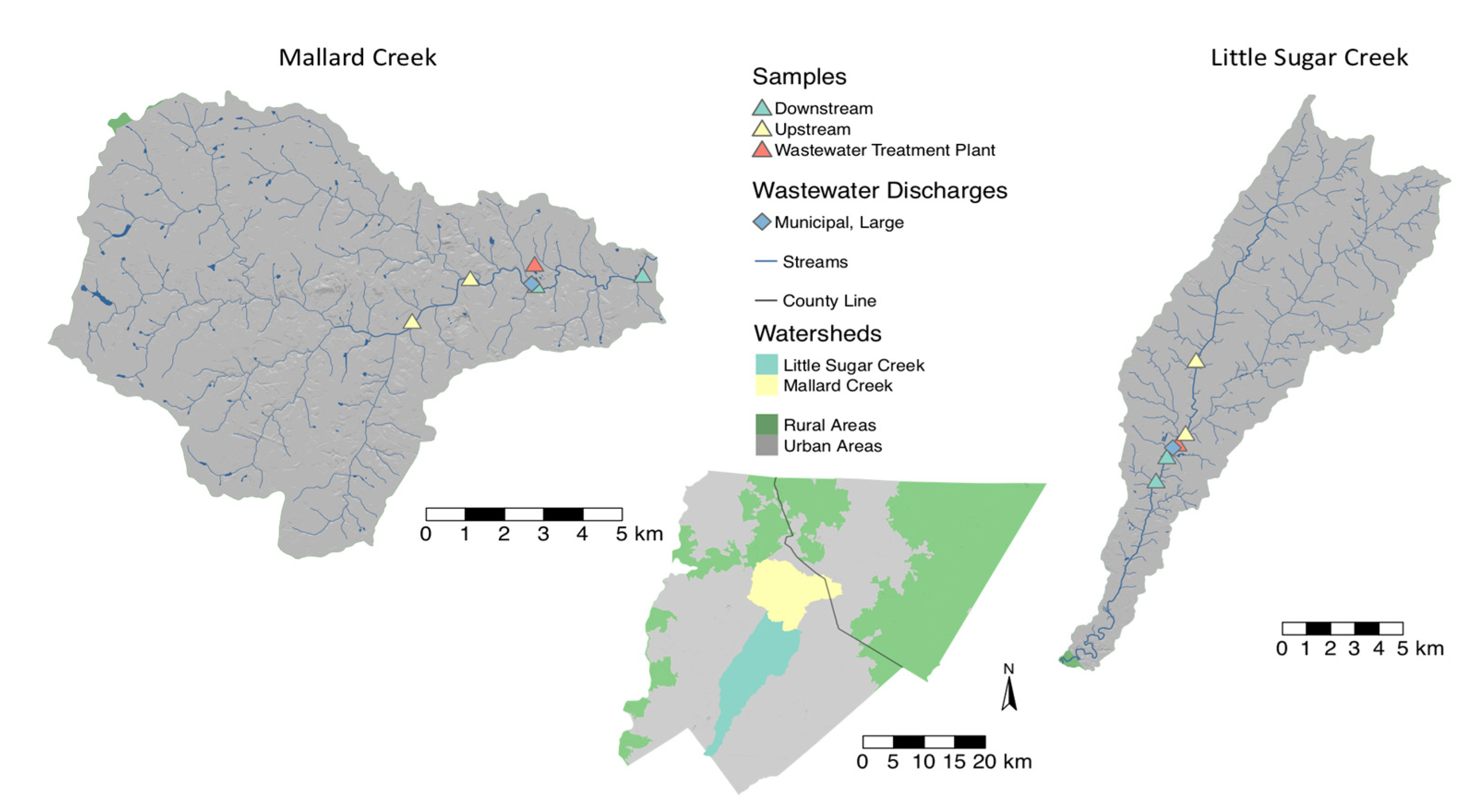

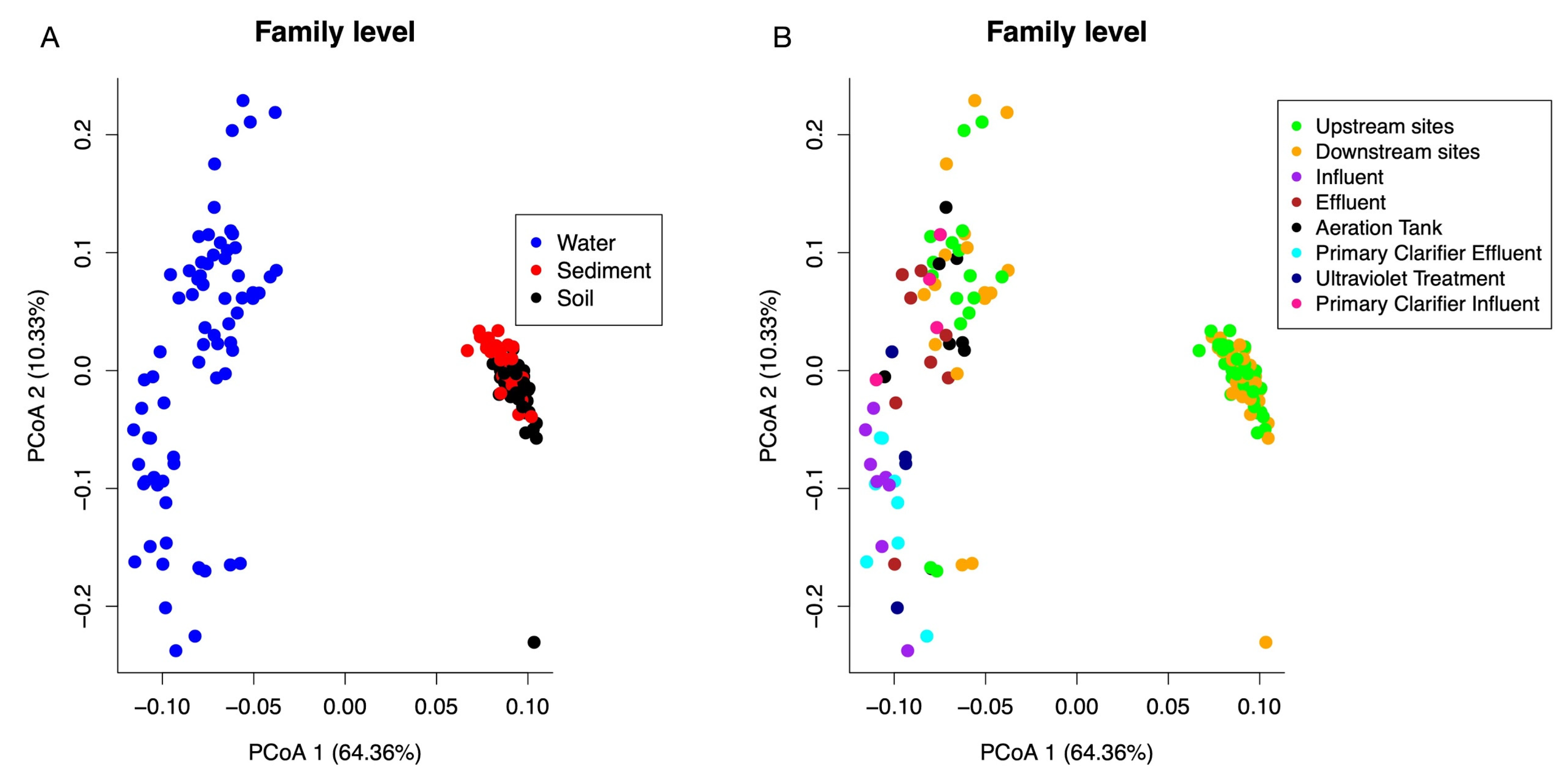

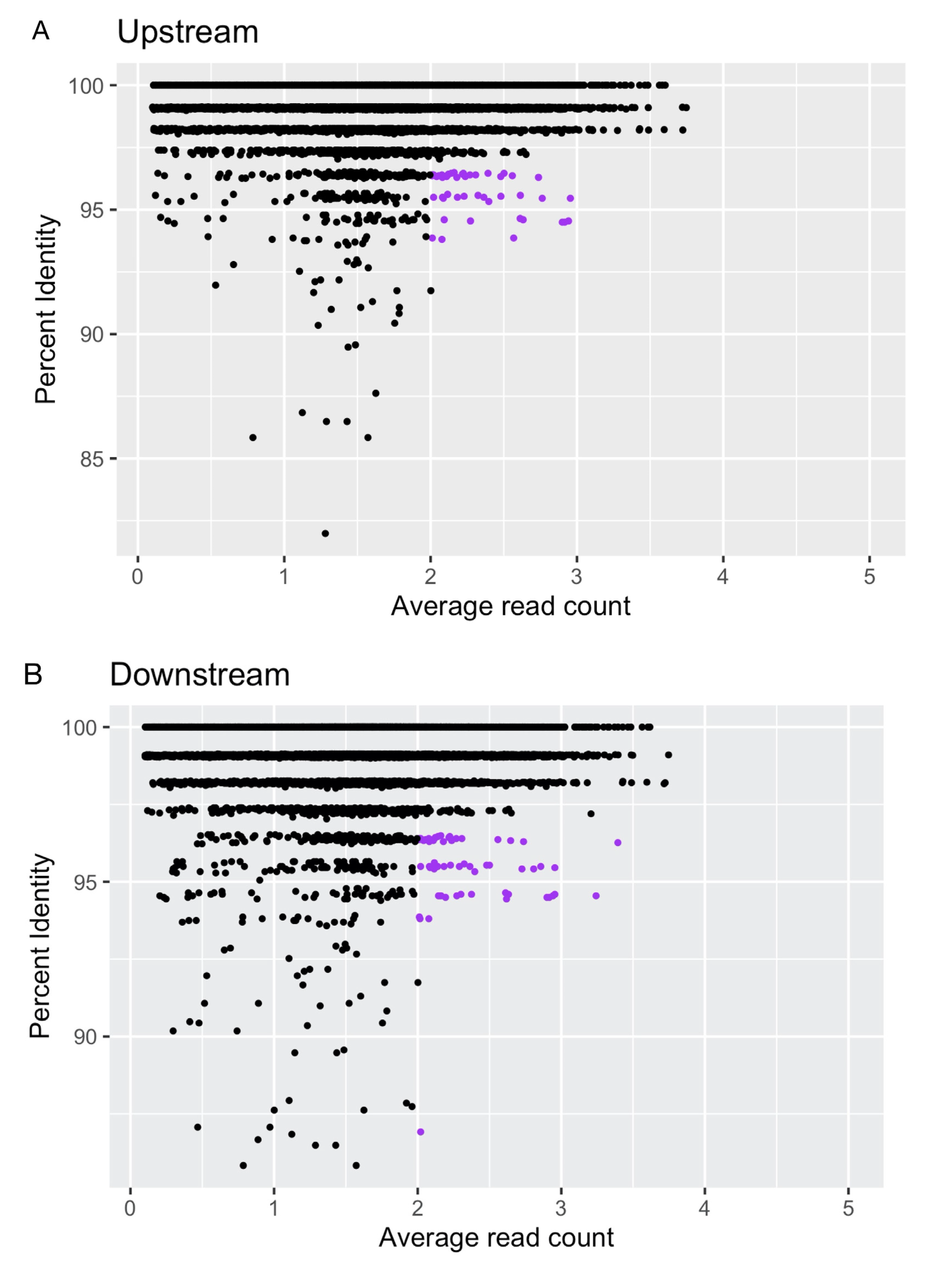
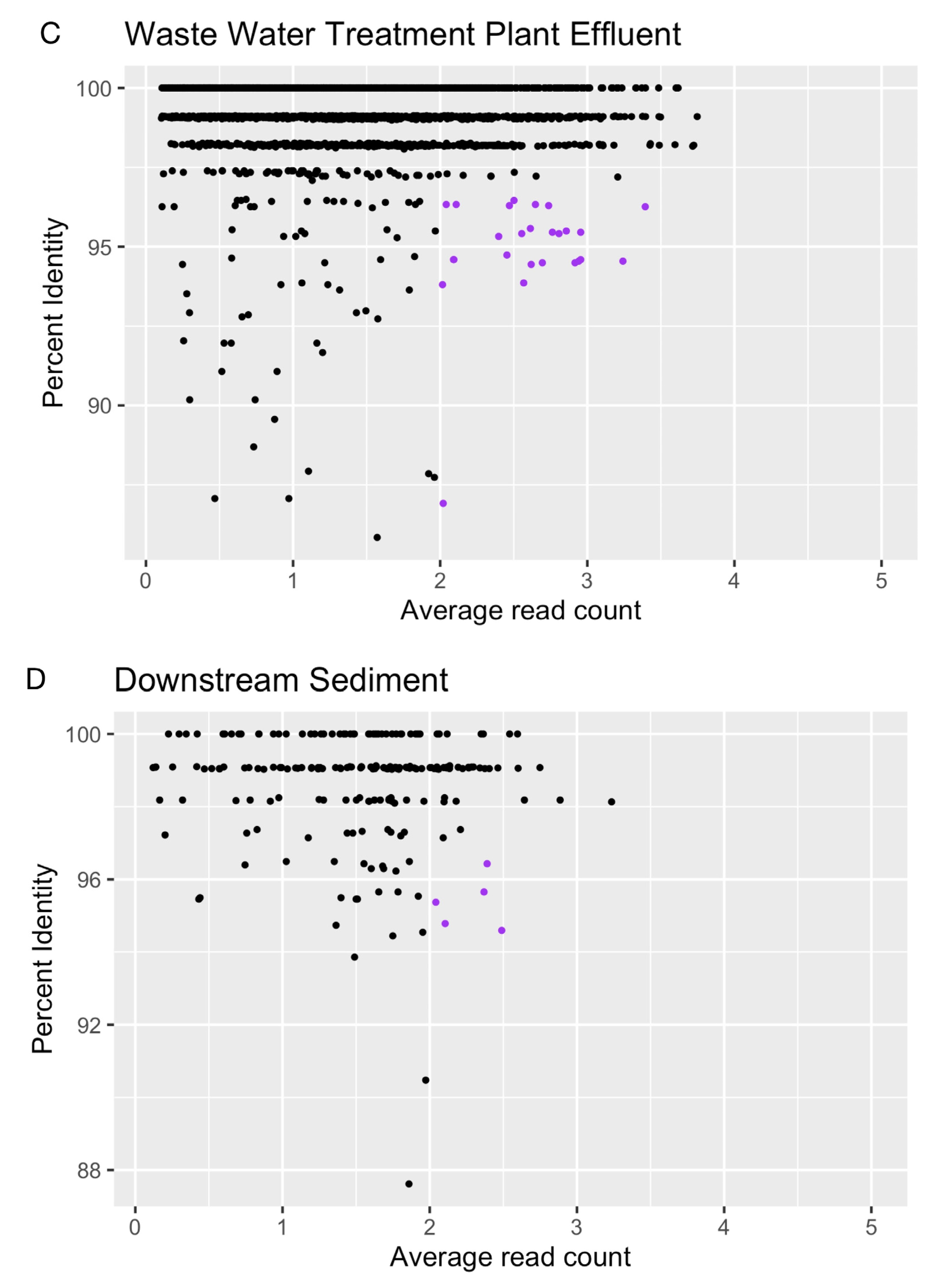
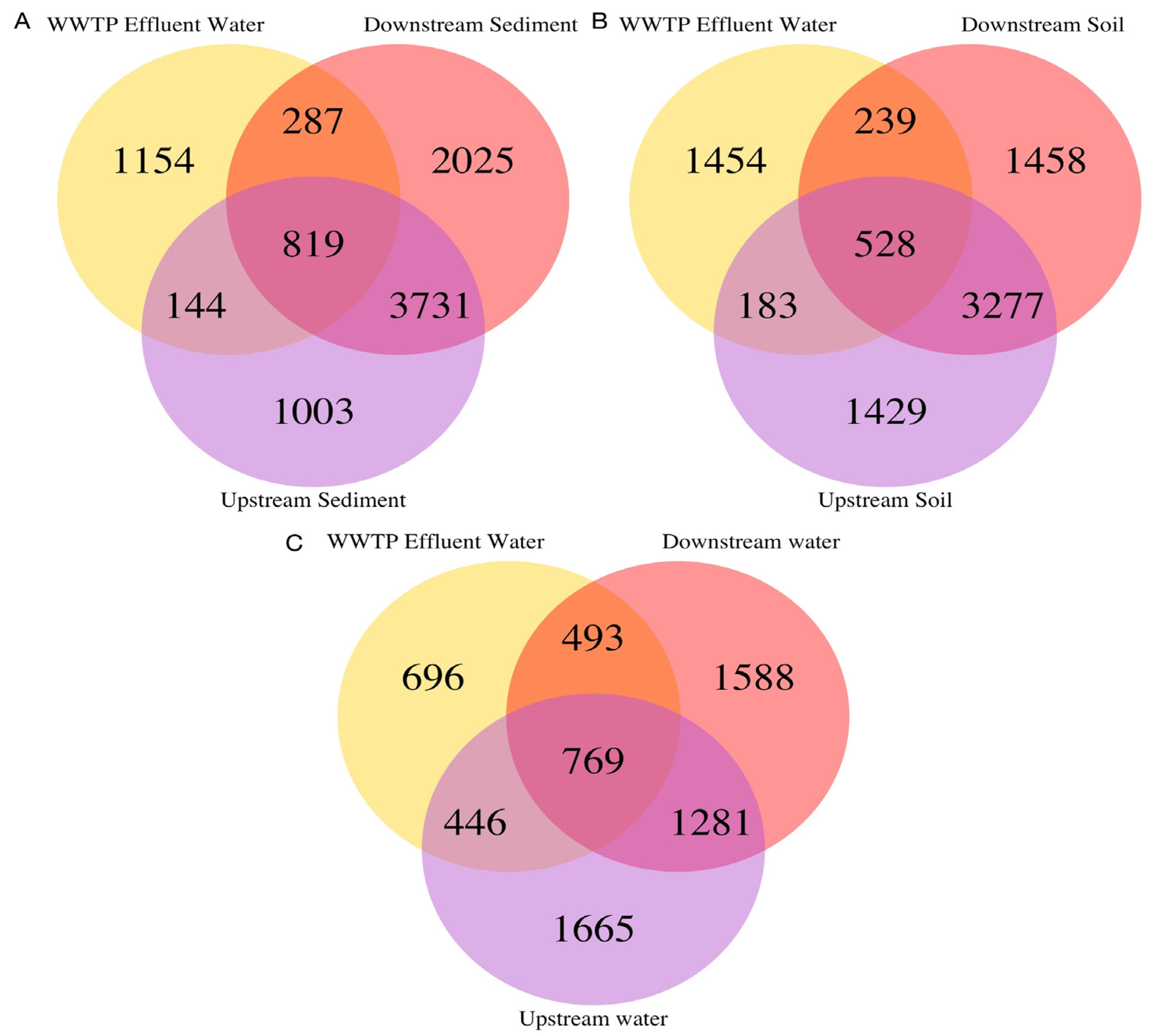
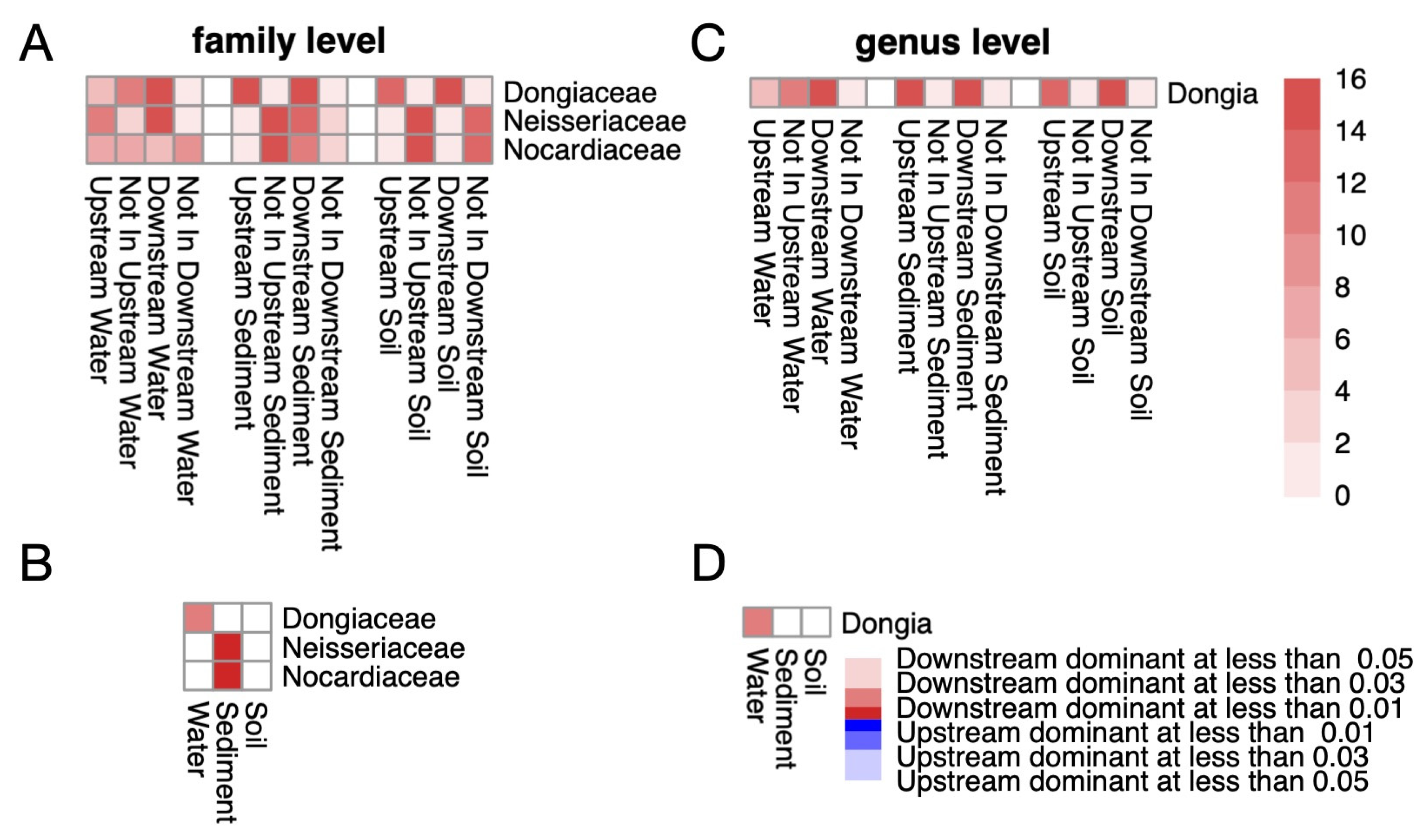
© 2020 by the authors. Licensee MDPI, Basel, Switzerland. This article is an open access article distributed under the terms and conditions of the Creative Commons Attribution (CC BY) license (http://creativecommons.org/licenses/by/4.0/).
Share and Cite
Clinton, S.; Johnson, J.; Lambirth, K.; Sun, S.; Brouwer, C.; Keen, O.; Redmond, M.; Fodor, A.; Gibas, C. Sediment Microbial Diversity in Urban Piedmont North Carolina Watersheds Receiving Wastewater Input. Water 2020, 12, 1557. https://doi.org/10.3390/w12061557
Clinton S, Johnson J, Lambirth K, Sun S, Brouwer C, Keen O, Redmond M, Fodor A, Gibas C. Sediment Microbial Diversity in Urban Piedmont North Carolina Watersheds Receiving Wastewater Input. Water. 2020; 12(6):1557. https://doi.org/10.3390/w12061557
Chicago/Turabian StyleClinton, Sandra, James Johnson, Kevin Lambirth, Shan Sun, Cory Brouwer, Olya Keen, Molly Redmond, Anthony Fodor, and Cynthia Gibas. 2020. "Sediment Microbial Diversity in Urban Piedmont North Carolina Watersheds Receiving Wastewater Input" Water 12, no. 6: 1557. https://doi.org/10.3390/w12061557
APA StyleClinton, S., Johnson, J., Lambirth, K., Sun, S., Brouwer, C., Keen, O., Redmond, M., Fodor, A., & Gibas, C. (2020). Sediment Microbial Diversity in Urban Piedmont North Carolina Watersheds Receiving Wastewater Input. Water, 12(6), 1557. https://doi.org/10.3390/w12061557




